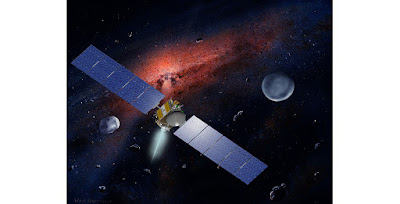In late 2015, images captured by NASA’s Dawn spacecraft showed bright spots on the dwarf planet Ceres. While the planet has been a mystery to scientists for long, Dawn has shed more light on the bright spots, and the planet in general, during its orbit of the dwarf planet. Going by the images, scientists have reported that the bright spots are made up of hydrated magnesium sulfates, more popular as Epsom salt that is used in treating sore and inflamed joints.
The white spots have fascinated scientists since they were discovered, and for a passionate researcher like Experimentor_4u, continued discovery of Ceres’ features have kept him hungry for more information.

Dawn’s mission
The Dawn Project was initiated by the National Aeronautics and Space Administration’s (NASA’s) Discovery Program as a project to increase the understanding of the conditions of some of the solar systems intriguing bodies, specifically the protoplanet’s Vesta and Ceres. The Dawn spacecraft orbited Vesta in 2011-2012, and from there moved to the dwarf planet Ceres.
So far, the Dawn mission has accomplished many firsts. It is the only spacecraft to successfully orbit two bodies other than Earth, and the only spacecraft to orbit a body located in the asteroid belt between Jupiter and Mars. By relaying images in its orbit, Dawn is able to send useful information that scientists can study to learn more about the planet.
Scientists believe that during the early stages of the solar system, the buildup of bodies contributed to the growth of planets. The process is, however, believed to have been interfered with by Jupiter’s gravity, thus denying the development of a planet between it and Mars. The result is a large asteroid belt that is home to Vesta and Ceres, two of the largest asteroids in the belt. Both planets have survived the collisions that are common between asteroids, and possess chemical conditions that might help shed light on the early stages of the solar system.
At a high level, the Dawn mission seeks to find answers on the role of size and water in establishing the growth of planets. Vesta and Ceres are the right candidates to provide answers, as they are planets whose growth was interrupted by Jupiter. While Ceres is wet and primal, Vesta is dry and has advanced. Thus, Dawn has the possibility of providing discoveries that further advance scientists’ knowledge of the solar system.
Ceres’ Bright Spots
On images relayed by Dawn, Ceres has more than 100 bright spots, with a significant number thought to be the linked to impact craters. Scientists at the Max Planck Institute for Solar System Research in Germany have studied these bright spots and found them to be consistent with magnesium sulfate, a variant of which is used as Epsom salt. The scientists have suggested that these bright spots are salt-rich areas that are a result of water redirection in the past, with asteroid impact likely to have brought the salt onto the surface.
Ceres has a dark surface, much similar to fresh asphalt. The bright spots are brought into focus as a result of sunlight, which also makes it possible to see the craters that dot the planet. One of the craters, called Occator, has been the center of study efforts to figure out the behavior of Ceres’ surface during particular times of the day.
In another study, the team of scientists behind studied the planet using special equipment to identify ammonia-rich soil. Because Ceres is a warm planet, ammonia by itself would evaporate. Scientists figure that the presence of ammonia could be a result of bonding with other minerals on planet’s surface. The presence of ammonia also leads to the possibility that Ceres might have originated outside the main asteroid belt, or that the planet is made up of materials that have coasted from other orbits.
Scientists’ ability to make accurate inferences is a result of Dawn’s instruments, which are a framing camera, a visible and infrared mapping spectrometer to a gamma ray and neutron detector. These instruments have kept the Dawn team busy, as the data collected has helped them understand the elements on Ceres’ surface, along with important details that may help address questions about the planet’s composition and evolution. Since Ceres is the last planet in Dawn’s space exploration itinerary, the spacecraft is expected to remain in the planet’s orbit until the conclusion of its mission in 2016.




